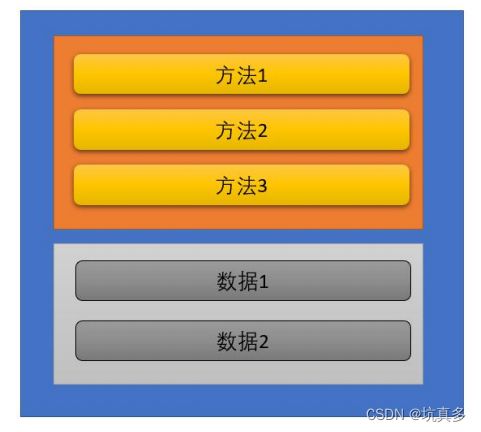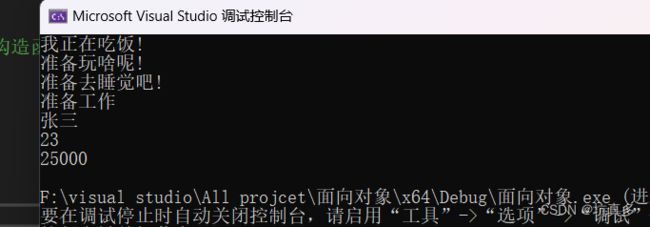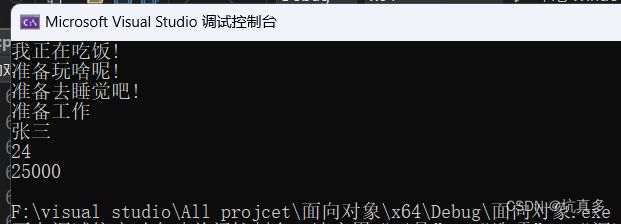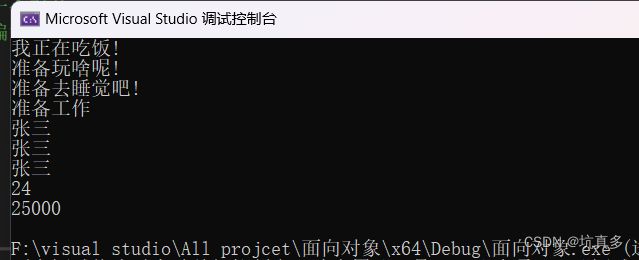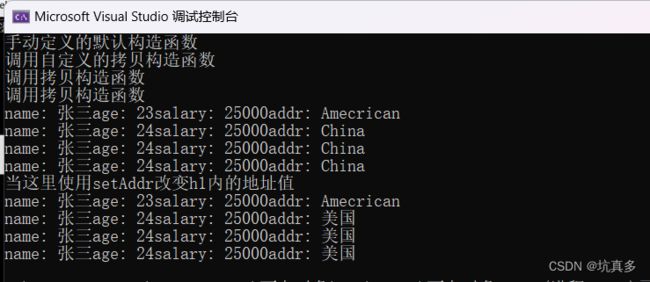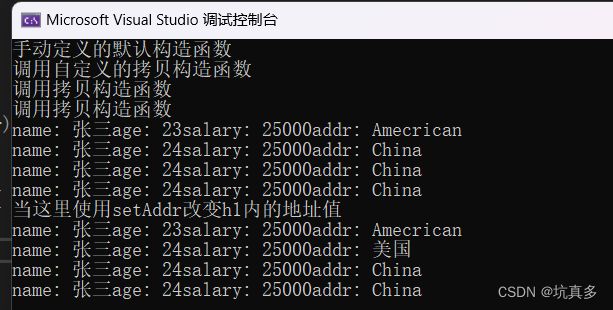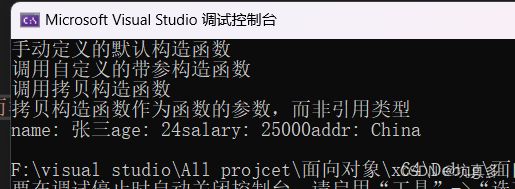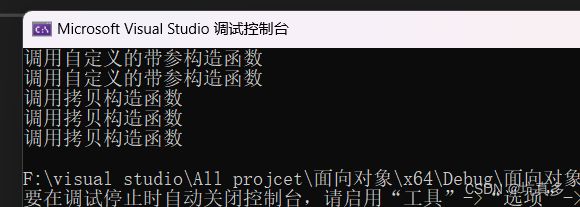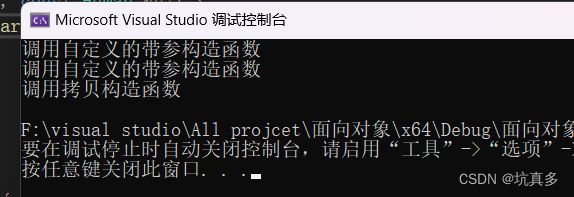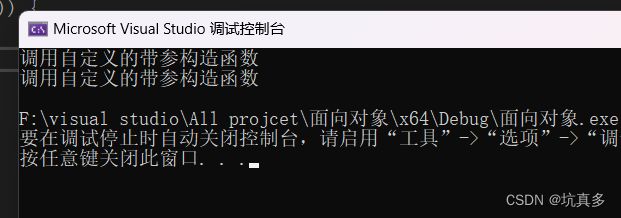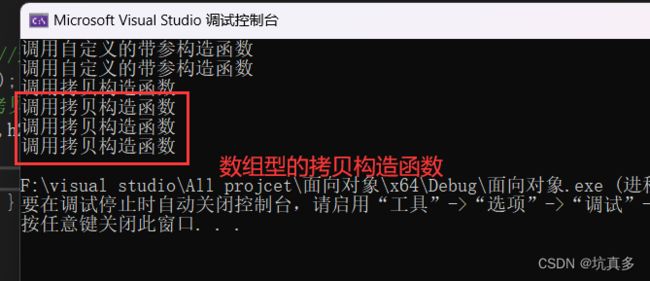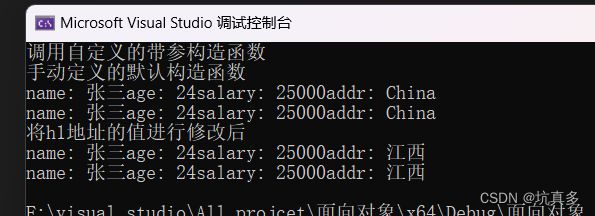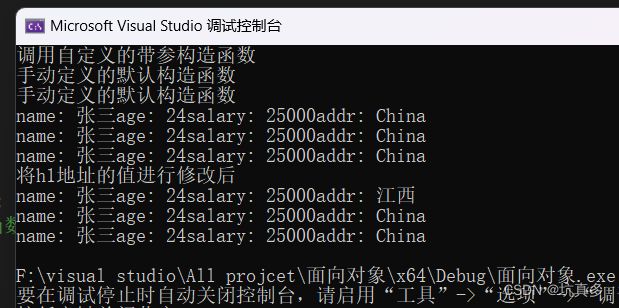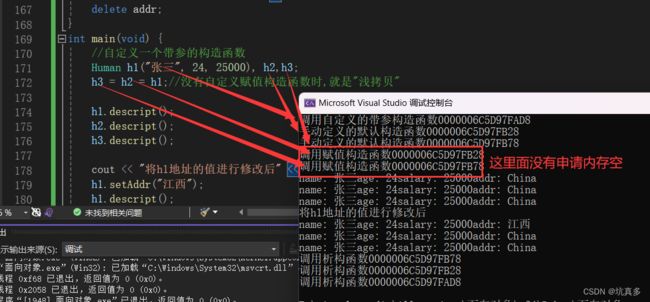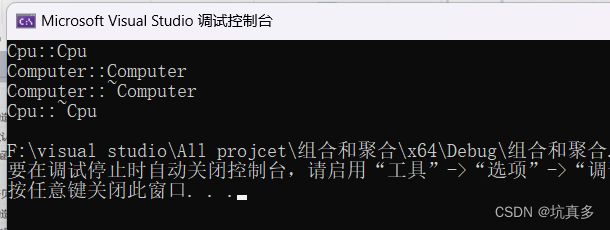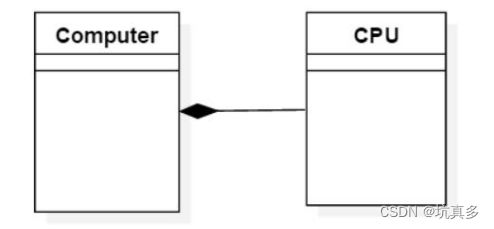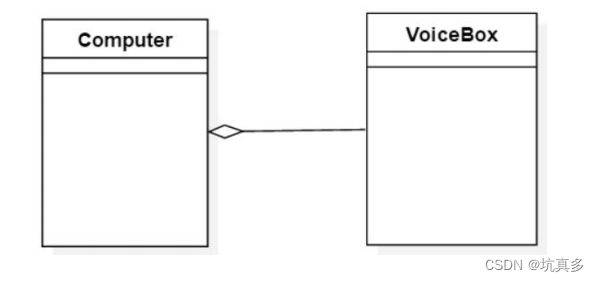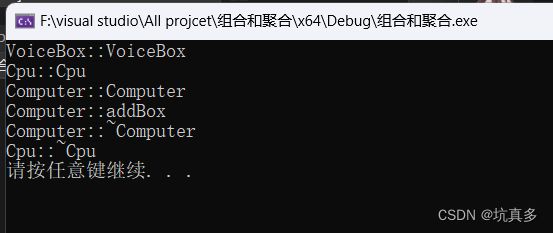第六站:C++面向对象
面向对象的第一概念:类
类的构成:
类的设计:
创建一个类:
class Human {
public://公有的,对外的
void eat();//方法,成员函数
void sleep();
void play();
void work();
string getName();//获取对内的数据
int getAge();
int getSalary();
private://对内的,私有的
string name;
int age;
int salary;
};成员函数及实现
/*
void eat();//方法,成员函数
void sleep();
void play();
void work();
*/
void Human::eat() {
cout << "我正在吃饭!" << endl;
}
void Human::sleep() {
cout << "准备去睡觉吧!" << endl;
}
void Human::play() {
cout << "准备玩啥呢!" << endl;
}
void Human::work() {
cout << "准备工作" << endl;
}成员数据通过函数调用
实现封装,数据获取get()
/*
成员数据
private://对内的,私有的
string name;
int age;
int salary;
*/
/*
调用成员数据的函数
string getName();//获取对内的数据
int getAge();
int getSalary();
*/
//实现对成员数据的获取
string Human::getName() {
return name;
}
int Human::getAge() {
return age;
}
int Human::getSalary() {
return salary;
}成员数据单个设置set()
/*
void setName(string name);//设置对内的数据
void setAge(int age);
void setSalary(int salary);
*/
//this是一个特殊的指针,指向这个对象本身
void Human::setName(string name1) {
this->name = name1;
}
void Human::setAge(int age1) {
this->age = age1;
}
void Human::setSalary(int salary1) {
this->salary = salary1;
}对象:
一个特定"类"的具体实例
Human h1;//h1就是Human这个类的一个对象,一个对象是一个特殊的变量,有丰富的功能和用法,可以通过对象去调用类的成员函数
特点:
具体使用方法:
int main(void) {
Human h1;//通过Human类创建一个对象
h1.eat();
h1.play();
h1.sleep();
h1.work();
//设置成员数据
h1.setName("张三");
//通过getName()来获取成员数据
cout << h1.getName() << endl;
//h1.age//直接访问成员数据是无法通过编译的
return 0;
}成员数据的初始化:构造函数(自动调用)
作用:
特点:
1: 自动调用 (在创建新对象时,自动调用)2: 构造函数的函数名,和类名相同3:构造函数 没有 返回类型4:可以有多个构造函数(即 函数重载形式 )(大致常用的有四种)
构造函数的种类
每一种构造函数都只有一个
默认构造函数
没有参数的构造函数,称为默认构造函数
合成的默认构造函数
在创建一个对象的时候,(1:当我们没写默认的构造函数时,编译器会自动创建一个"合成的默认构造函数")--->这个值都是随机的,并不准确
仅当数据成员全部使用了“类内初始值”,才宜使用“合成的默认构造函数”
int age = 18;//设置类内初始值(仅C11以上才支持)
//通过getAge()来获取成员数据
cout << h1.getAge() << endl;//使用类内初始值(仅C11以上才支持)
//通过getName()来获取成员数据
cout << h1.getSalary() << endl;//没有使用类内初始值
手动定义默认构造函数
防止编译器自动编译一个合成的默认构造函数
Human();//手动定义默认构造函数
//手动定义的默认构造函数
Human::Human(){
name = "张三";
age = 23;
salary = 25000;
}
自定义带参构造函数(会覆盖类内初始值)
与自定义默认构造函数不同的是,(默认的是在初始化的时候值都是固定的,带参的可以根据不同对象设置不同的初始化值)
this是一个特殊的指针,指向这个对象本身
/*
类内
//手动定义带参的(重载)构造函数
Human(string name,int age,int salary);
*/
/*
类外
//自定义重载构造函数
Human::Human(string name, int age, int salary){
this->age = age;//this是一个特殊的指针
this->name = name;
this->salary = salary;
}
*/
int main(void) {
//自定义一个带参的构造函数
Human h1("张三",24,25000);//通过Human类创建一个对象
h1.eat();
h1.play();
h1.sleep();
h1.work();
//通过getName()来获取成员数据
cout << h1.getName() << endl;
//通过getAge()来获取成员数据
cout << h1.getAge() << endl;
//通过getName()来获取成员数据
cout << h1.getSalary() << endl;
//h1.age//直接访问成员数据是无法通过编译的
return 0;
}拷贝构造函数
合成的拷贝构造函数(一般有问题)
Human h1("张三",24,25000);//通过Human类创建一个对象
Human h2 = h1;//第一种形式:在没有自定义拷贝构造函数时,编译器会默认调用"合成拷贝构造函数"一般有问题
Human h3(h2);//第二种形式
//通过getName()来获取成员数据
cout << h1.getName() << endl;
cout << h2.getName() << endl;
cout << h3.getName() << endl;那合成拷贝构造函数的问题
当数据成员是个指针的时候就会出现"浅拷贝"或者"位拷贝"直接复制拷贝对象的所有数据值
#include
#include
using namespace std;
#define size 16
class Human {
public://公有的,对外的
void eat();//方法,成员函数
void sleep();
void play();
void work();
void descript();
//自定义的默认构造函数
Human();
//手动定义带参的(重载)构造函数
Human(string name,int age,int salary);
//手动定义拷贝构造函数
//Human(const Human& other);
void setName(string name);//设置对内的数据
void setAge(int age);
void setSalary(int salary);
void setAddr(char* addr);
string getName();//获取对内的数据
int getAge();
int getSalary();
private://对内的,私有的
string name;
int age;//设置类内初始值
int salary;
char* addr;
};
//成员描述信息
void Human::descript()
{
cout << "name: " << getName()
<< "age: " << getAge()
<< "salary: " << getSalary()
<<"addr: "<age = age;
this->name = name;
this->salary = salary;
addr = new char[32];
strcpy_s(addr,size, "China");
}
//相当于 Human h2 = h1; //const Human &other = h1;
//Human::Human(const Human& other){
// cout << "调用拷贝构造函数" << endl;
// this->age = other.age;
// this->name = other.name;
// this->salary = other.salary;
//}
void Human::setAddr(char* addr)
{
if (!addr){
return;
}
strcpy_s(this->addr, size, addr);
}
int main(void) {
Human h;
//自定义一个带参的构造函数
Human h1("张三",24,25000);//通过Human类创建一个对象
Human h2 = h1;//第一种形式:在没有自定义拷贝构造函数时,编译器会默认调用"合成拷贝构造函数"一般有问题
Human h3(h2);//第二种形式
h.descript();
h1.descript();
h2.descript();
h3.descript();
//当这里使用setAddr改变h1内的地址值
cout << "当这里使用setAddr改变h1内的地址值" << endl;
h1.setAddr("美国");
h.descript();
h1.descript();
h2.descript();
h3.descript();
return 0;
} 自定义拷贝构造函数(const的引用类型)
#include
#include
using namespace std;
#define size 16
class Human {
public://公有的,对外的
void eat();//方法,成员函数
void sleep();
void play();
void work();
void descript();
//自定义的默认构造函数
Human();
//手动定义带参的(重载)构造函数
Human(string name,int age,int salary);
//手动定义拷贝构造函数
Human(const Human& other);
void setName(string name);//设置对内的数据
void setAge(int age);
void setSalary(int salary);
void setAddr(char* addr);
string getName();//获取对内的数据
int getAge();
int getSalary();
private://对内的,私有的
string name;
int age;//设置类内初始值
int salary;
char* addr;
};
//成员描述信息
void Human::descript()
{
cout << "name: " << getName()
<< "age: " << getAge()
<< "salary: " << getSalary()
<<"addr: "<age = age;
this->name = name;
this->salary = salary;
addr = new char[32];
strcpy_s(addr,size, "China");
}
//相当于 Human h2 = h1; //const Human &other = h1;
Human::Human(const Human& other){
cout << "调用拷贝构造函数" << endl;
this->age = other.age;
this->name = other.name;
this->salary = other.salary;
//为addr分配一块独立的内存空间,不进行浅拷贝
addr = new char[32];
strcpy_s(addr, size, other.addr);
}
void Human::setAddr(char* addr)
{
if (!addr){
return;
}
strcpy_s(this->addr, size, addr);
}
int main(void) {
Human h;
//自定义一个带参的构造函数
Human h1("张三",24,25000);//通过Human类创建一个对象
Human h2 = h1;//第一种形式:在没有自定义拷贝构造函数时,编译器会默认调用"合成拷贝构造函数"一般有问题
Human h3(h2);//第二种形式
h.descript();
h1.descript();
h2.descript();
h3.descript();
//当这里使用setAddr改变h1内的地址值
cout << "当这里使用setAddr改变h1内的地址值" << endl;
h1.setAddr("美国");
h.descript();
h1.descript();
h2.descript();
h3.descript();
return 0;
} 调用时机
1:拷贝构造函数作为函数的参数,而非引用类型
如果参数是引用类型的话,函数内是可以直接修改,引用对象的数据值的,但是这种方式是不会创建新的对象的可以节省空间(如果设置不行值被修改,可以将成员函数和引用参数类型都定义为const类型,那么引用的这个对象就无法修改非const的值)禁止值被修改,就和拷贝构造函数一样了)
非引用的话,修改值,那值也是也是新的对象的
/*
//拷贝构造函数作为函数的参数,而非引用类型
//相当于就是Human h2 = h1;
void type1(Human h2) {
cout << "拷贝构造函数作为函数的参数,而非引用类型" << endl;
cout << "name: " << h2.getName()
<< "age: " << h2.getAge()
<< "salary: " << h2.getSalary()
<< "addr: " << h2.getAddr() << endl;
}
*/
/*
//如果时引用的话,是不会创建新的对象
void type2(Human &h2) {//相当于别名
cout << "拷贝构造函数作为函数的参数,是引用类型" << endl;
cout << "name: " << h2.getName()
<< "age: " << h2.getAge()
<< "salary: " << h2.getSalary()
<< "addr: " << h2.getAddr() << endl;
}
*/
int main(void) {
Human h;
//自定义一个带参的构造函数
Human h1("张三",24,25000);//通过Human类创建一个对象
//调用拷贝构造函数时机1:拷贝构造函数作为函数的参数,而非引用类型
//type1(h1);
type2(h1);
return 0;
}2:函数的返回类型是类,而不是引用类型
#include
#include
using namespace std;
#define size 16
class Human {
public://公有的,对外的
void eat();//方法,成员函数
void sleep();
void play();
void work();
void descript();
//自定义的默认构造函数
Human();
//手动定义带参的(重载)构造函数
Human(string name,int age,int salary);
//手动定义拷贝构造函数
Human(const Human& other);
void setName(string name);//设置对内的数据
void setAge(int age);
void setSalary(int salary);
void setAddr(char* addr);
string getName()const;//获取对内的数据
int getAge()const;
int getSalary()const;
char* getAddr() const;
private://对内的,私有的
string name;
int age;//设置类内初始值
int salary;
char* addr;
};
//成员描述信息
void Human::descript()
{
cout << "name: " << getName()
<< "age: " << getAge()
<< "salary: " << getSalary()
<<"addr: "<age = age;
this->name = name;
this->salary = salary;
addr = new char[32];
strcpy_s(addr,size, "China");
}
//相当于 Human h2 = h1; //const Human &other = h1;
Human::Human(const Human& other){
cout << "调用拷贝构造函数" << endl;
this->age = other.age;
this->name = other.name;
this->salary = other.salary;
//为addr分配一块独立的内存空间,不进行浅拷贝
addr = new char[32];
strcpy_s(addr, size, other.addr);//设置值为深拷贝
}
//拷贝构造函数作为函数的参数,而非引用类型
void type1(Human h2) {
cout << "拷贝构造函数作为函数的参数,而非引用类型" << endl;
cout << "name: " << h2.getName()
<< "age: " << h2.getAge()
<< "salary: " << h2.getSalary()
<< "addr: " << h2.getAddr() << endl;
}
//函数的返回类型是类,参数是对象,而非引用类型
//这个函数会返回一个临时的对象,这个对象会调用拷贝构造函数,加上参数的两个,这里一共会调用三次拷贝构造函数
//这里可以将参数设置为引用类型,避免浪费资源(其他成员函数最好设置为const的类型,避免值无意间自己给修改了)
//返回的类型也可以设置为引用类型,避免创建临时对象
const Human& getBetterMan(const Human &h1, const Human &h2) {
if (h1.getSalary() > h2.getSalary()) {
return h1;
}
else {
return h2;
}
}
void Human::setName(string name1) {
this->name = name1;
}
void Human::setAge(int age1) {
this->age = age1;
}
void Human::setSalary(int salary1) {
this->salary = salary1;
}
void Human::setAddr(char* addr)
{
if (!addr){
return;
}
strcpy_s(this->addr, size, addr);
}
int main(void) {
//自定义一个带参的构造函数
Human h1("张三",24,25000);//通过Human类创建一个对象
Human h2("王五", 24, 26000);
//调用拷贝构造函数时机1:拷贝构造函数作为函数的参数,而非引用类型
getBetterMan(h1,h2);//这个函数会返回一个临时的对象,这个对象会调用拷贝构造函数
return 0;
} 3:对象是数组:
Human men[] = { h1, h2, h3 }; //调用 3 次拷贝构造函数
赋值构造函数
赋值构造函数和拷贝构造函数的区别
拷贝构造函数是在创建对象的时候,将其他对象拷贝给他,
Human h1 = h2;//这种就是拷贝构造函数
但是当将已经存在的对象进行赋值的就不是拷贝构造函数了,而是调用的赋值构造函数
Human h1,h2;
h1 = h2;//这种就是赋值构造函数
合成的赋值构造函数(浅拷贝)
和拷贝构造函数有点类似
int main(void) {
//自定义一个带参的构造函数
Human h1("张三", 24, 25000), h2;
h2 = h1;
h1.descript();
h2.descript();
cout << "将h1地址的值进行修改后" << endl;
h1.setAddr("江西");
h1.descript();
h2.descript();
return 0;
}自定义赋值构造函数
/*
类内
//手动定义赋值构造函数,
// 运算符重载"operator ="
Human& operator= (const Human & other1);
*/
/*
//类外
//赋值构造函数,&Human等同于h1
//const型的 h2
Human &Human::operator= (const Human& other1) {
//防止对象给自己赋值
if (this == &other1) {
//如果对象给自己赋值,就返回对象本身的指针
return *this;
}
//当执行h2 = h1时
//就相当于调用h2.operator =(h1);
this->name = other1.name;
this->age = other1.age;
this->salary = other1.salary;
//如果有必要可以先释放原本对象的资源
//看情况,因为对象生成的时候本身就有一块内存
/*delete addr;
addr = new char[64];*/
strcpy_s(this->addr, size, other1.addr);//深拷贝
//返回对象本身this的引用*this,以方便做链式处理,h3=h2=h1;
return *this;//return this 这种只是返回对象的指针,这个对象如果继续给下一个对象赋值的,就是空的
}
*/
int main(void) {
//自定义一个带参的构造函数
Human h1("张三", 24, 25000), h2,h3;
h3 = h2 = h1;//没有自定义赋值构造函数时,就是"浅拷贝"
h1.descript();
h2.descript();
h3.descript();
cout << "将h1地址的值进行修改后" << endl;
h1.setAddr("江西");
h1.descript();
h2.descript();
h3.descript();
return 0;
}析构函数(自动调用)
当对象内部构造函数申请多个内存空间之后,由于这个空间都是在堆空间里,对象消亡之后,堆空间里的内存空间依然存在,又因为在对象内部,使用delete运算符去清空,首先很繁琐,
这时候就要用到析构函数.析构函数是没有参数,没有返回类型的,而且只有一个
构造函数申请了多少空间,就释放多少空间
一个波浪线+类名();:~Human();,可以看出,谁先调用完,谁就先释放
Human::~Human() {
//这里加个this,谁来调用就返回这个对象的指针,在其他对象中也加入就可以判断调用的先后顺序
cout << "调用析构函数" << this<this指针:
是一个特殊的指针,放回这个对象本身,this指针是属于实例对象,不能访问静态方法(不属于某一个实例对象,属于共有的,大众的,由类直接调用)
第一种用法:
void Human::setName(string name1) {
this->name = name1;
}
void Human::setAge(int age1) {
this->age = age1;
}
void Human::setSalary(int salary1) {
this->salary = salary1;
}第二三种用法:引用和指针
![]()
//this指针的用法两种
const Human* comBetterMan(const Human*);
const Human& comBetterMan1(const Human&);
/*
//当返回对象是指针时
const Human *Human::comBetterMan(const Human *other) {
if (this->getSalary() >other->getSalary()) {
return this;
}
else {
return other;
}
}
//当返回对象是引用时
const Human& Human::comBetterMan1(const Human&other) {
if (this->getSalary() > other.getSalary()) {
return *this;
}
else {
return other;
}
}
*/
int main(void) {
//自定义一个带参的构造函数
Human h1("张三", 24, 25000);
Human h2("李四", 40, 50000);
cout << "用指针返回的是:" << h1.comBetterMan(&h2) << endl;
cout << "用引用返回的是:" << &h1.comBetterMan1(h2) << endl;
return 0;
}类文件的分离
分为定义(.h的文件中)和实现(.cpp文件中)两个部分和一个主函数(main)文件.cpp
.h中
#pragma once
#include
#include
using namespace std;
class Human {
public://公有的,对外的
void eat();//方法,成员函数
void sleep();
void play();
void work();
void descript();
//自定义的默认构造函数
Human();
~Human();
//手动定义带参的(重载)构造函数
Human(string name, int age, int salary);
//手动定义拷贝构造函
Human(const Human& other);
//手动定义赋值构造函数,
// 运算符重载"operator ="
Human& operator= (const Human& other1);
void setName(string name);//设置对内的数据
void setAge(int age);
void setSalary(int salary);
void setAddr(char* addr);
//this指针的用法两种
const Human* comBetterMan(const Human*);
const Human& comBetterMan1(const Human&);
string getName()const;//获取对内的数据
int getAge()const;
int getSalary()const;
char* getAddr() const;
private://对内的,私有的
string name;
int age;//设置类内初始值
int salary;
char* addr;
}; 实现 .cpp中代码
#include "Human.h"
#define size 16
string Human::getName() const {
return name;
}
int Human::getAge() const {
return age;
}
int Human::getSalary() const {
return salary;
}
char* Human::getAddr() const
{
return addr;
}
//手动定义的默认构造函数
Human::Human() {
cout << "手动定义的默认构造函数" << this << endl;
name = "张三";
age = 23;
salary = 25000;
addr = new char[32];
strcpy_s(addr, size, "Amecrican");
}
//自定义重载构造函数
Human::Human(string name, int age, int salary) {
cout << "调用自定义的带参构造函数" << this << endl;
this->age = age;
this->name = name;
this->salary = salary;
addr = new char[32];
strcpy_s(addr, size, "China");
}
//相当于 Human h2 = h1; //const Human &other = h1;
Human::Human(const Human& other) {
cout << "调用拷贝构造函数" << endl;
this->age = other.age;
this->name = other.name;
this->salary = other.salary;
//为addr分配一块独立的内存空间,不进行浅拷贝
addr = new char[32];
strcpy_s(addr, size, other.addr);//设置值为深拷贝
}
//如果时引用的话,是不会创建新的对象
//void type2(const Human& h2) {//相当于别名
// cout << "拷贝构造函数作为函数的参数,是引用类型" << endl;
// //h2.setAddr("芜湖");//可以修改值,定义为const就不能修改了
// cout << "name: " << h2.getName()
// << "age: " << h2.getAge()
// << "salary: " << h2.getSalary()
// << "addr: " << h2.getAddr() << endl;
//}
//函数的返回类型是类,而非引用类型,,参数是对象,而非引用类型
//这个函数会返回一个临时的对象,这个对象会调用拷贝构造函数,加上参数的两个,这里一共会调用三次拷贝构造函数
//这里可以将参数设置为引用类型,避免浪费资源(其他成员函数最好设置为const的类型,避免值无意间自己给修改了)
//返回的类型也可以设置为引用类型,避免创建临时对象
const Human& getBetterMan(const Human& h1, const Human& h2) {
if (h1.getSalary() > h2.getSalary()) {
return h1;
}
else {
return h2;
}
}
//赋值构造函数,&Human等同于h1
//const型的 h2
Human& Human::operator= (const Human& other1) {
cout << "调用赋值构造函数" << this << endl;
//防止对象给自己赋值
if (this == &other1) {
//如果对象给自己赋值,就返回对象本身的指针
return *this;
}
//当执行h2 = h1时
//就相当于调用h2.operator =(h1);
this->name = other1.name;
this->age = other1.age;
this->salary = other1.salary;
//如果有必要可以先释放原本对象的资源
//看情况,因为对象生成的时候本身就有一块内存
delete addr;
addr = new char[64];
strcpy_s(this->addr, size, other1.addr);//深拷贝
//返回对象本身的引用,以方便做链式处理,h3=h2=h1;
return *this;//return this 这种只是返回对象的指针,这个对象如果继续给下一个对象赋值的,就是空的
}
void Human::setName(string name1) {
this->name = name1;
}
void Human::setAge(int age1) {
this->age = age1;
}
void Human::setSalary(int salary1) {
this->salary = salary1;
}
void Human::setAddr(char* addr)
{
if (!addr) {
return;
}
strcpy_s(this->addr, size, addr);
}
//当返回对象是指针时
const Human* Human::comBetterMan(const Human* other) {
if (this->getSalary() > other->getSalary()) {
return this;
}
else {
return other;
}
}
//当返回对象是引用时
const Human& Human::comBetterMan1(const Human& other) {
if (this->getSalary() > other.getSalary()) {
return *this;
}
else {
return other;
}
}
Human::~Human() {
//这里加个this,谁来调用就返回这个对象的指针,在其他对象中也加入就可以判断调用的先后顺序
cout << "调用析构函数" << this << endl;
delete addr;
}主函数.cpp
#include
#include
#include "Human.h"
using namespace std;
#define size 16
//成员描述信息
void Human::descript() {
cout << "name: " << getName()
<< "age: " << getAge()
<< "salary: " << getSalary()
<< "addr: " << addr << endl;//可以直接访问,只是不安全
}
//拷贝构造函数作为函数的参数,而非引用类型
void type1(Human h2) {
cout << "拷贝构造函数作为函数的参数,而非引用类型" << endl;
cout << "name: " << h2.getName()
<< "age: " << h2.getAge()
<< "salary: " << h2.getSalary()
<< "addr: " << h2.getAddr() << endl;
}
int main(void) {
//自定义一个带参的构造函数
Human h1("张三", 24, 25000);
Human h2("李四", 40, 50000);
cout << "用指针返回的是:" << h1.comBetterMan(&h2) << endl;
cout << "用引用返回的是:" << &h1.comBetterMan1(h2) << endl;
return 0;
} static关键字
弥补使用全局变量不方便,破坏程序的封装性,就是用静态
对于非 const 的类静态成员
头文件.h
class Human{
public:
......
private:
....
static int count;
....
};
实现文件.cpp
//初始化静态成员
//对于非 const 的类静态成员,只能在类的实现文件中初始化。
int Human::count = 0;
const 类静态成员
可以在类内设置初始值,也可以在类的实现文件中设置初始值。(但是 不要同时在这两个地方初始化,只能初始化 1 次)
类的静态方法:别人可以访问他,但是他不能访问别人
优点:可以节省创建对象来调用成员函数,因为静态的成员函数可以用类来调用1. 可以直接通过 类来访问【更常用】 ,也可以通过 对象(实例)来访问 。/ 直接通过类名来访问静态方法!
// 用法:类名::静态方法2. 在类的静态方法中,不能访问普通数据成员和普通成员函数(对象的数据成员和成员函数)静态方法中,只能访问静态数据成员静态方法的实现,不能加 static
#pragma once
......
class Human {
public:
......
static int getCount();
......
};
实现文件中
//静态方法的实现,不能加 static
int Human::getCount() {
// 静态方法中,不能访问实例成员(普通的数据成员)
// cout << age;
// 静态方法中,不能访问 this 指针,因为 this 指针是属于实例对象的
// cout << this;
//静态方法中,只能访问静态数据成员
return count;
}
//静态方法:别人可以访问他,但是他不能访问别人
void test() {
cout << "总人数: ";
// ??? 没有可用的对象来访问 getCount()
// 直接通过类名来访问静态方法!
// 用法:类名::静态方法
cout << Human::getCount();
}
int main(void) {
//自定义一个带参的构造函数
Human h1("张三", 24, 25000);
Human h2("李四", 40, 50000);
//可以通过类名访问静态成员方法,也可以通过实例对象
cout << Human::getCount() << endl;
cout << h1.getCount() << endl;
return 0;
}所有的成员函数(),都可以访问静态数据成员。
类可以直接访问public静态数据成员(Human::count 非法)但是不能访问私有的静态数据成员
对象可以直接访问静态成员函数
类可以直接访问静态成员函数
在类的静态成员函数(类的静态方法)内部,不能直接访问 this 指针和对象的数据成员!
![]()
const关键字
const成员数据
只能读不能写
初始化:
设置类内初始值,(C11以上版本支持)
const char BloodType = 'B';
使用构造函数的初始化列表:一个冒号+const成员('初始值')
Human::Human(string name, int age, int salary):BloodType('A')
如何做到灵活初始化,用带参的构造函数的参数列表里定义一个形参,去表示初始化列表里的值
![]()
/*
Human(string name, int age, int salary,string BloodType);
const string BloodType = "B";
*/
实现文件
//在定义的对象的时候就可以灵活的设置初始值了
Human::Human(string name, int age, int salary,string BloodType):BloodType(BloodType) {
}
int main(void) {
//自定义一个带参的构造函数
Human h1("张三", 24, 25000,"AB");
Human h2("李四", 40, 50000,"A");
h1.descript();
h2.descript();
return 0;
}const成员函数
如果一个成员函数内部,不会修改任何数据成员,就把它定义为 const 成员函数。
const方法只能调用const方法,非const可以调用const方法
![]()
void descript() const;
//成员描述信息
void Human::descript() const{//这个函数里面就不能修改数据
cout << "name: " << getName()
<< "age: " << getAge()
<< "salary: " << getSalary()
<< "addr: " << addr
<< "bloodType:"<组合和聚合
组合:类里添加其他类
#pragma once
#include "Cpu.h"
class Computer{
public:
Computer();
~Computer();
private:
Cpu cpu;//Cpu和Computer之间,就是"组合"
//Cpu *cpu;使用指针
int hardDisk;//硬盘
int memory;//内存
};
组合:构造函数初始化值:
调用外类的成员数据之间通过外部类名调用,
//this->cpu = Cpu(cpuBrand, cpuVersion);
通过初始化列表
// :cpu(cpuBrand,cpuVersion)//使用初始化列表
cout << __FUNCTION__ << endl;如果调用这个函数就返回这个函数
使用指针调用外类和使用对象来调用外类效果一样
错误 C2040 “Computer::cpu”:“Cpu *”与“Cpu”的间接寻址级别不同
当报错这个,有可能是写的两种调用方式名字重名
(Cpu.h)
Cpu(const char *brand = "intel",const char *version = "i7");
Cpu::Cpu(const char *brand, const char *version){
this->brand = brand;
this->version = version;
cout << __FUNCTION__ << endl;//如果调用该函数就返回这个函数
}
(Computer.h)
Computer(const char *cpuBrand,const char *cpuVersion,
const int hardDisk,const int memory );
Computer::Computer(const char* cpuBrand, const char* cpuVersion,
const int hardDisk, const int memory):cpu(cpuBrand,cpuVersion)//使用初始化列表
{
//调用外类的成员数据之间通过外部类名调用,
//this->cpu = Cpu(cpuBrand, cpuVersion);
//this->cpu =new Cpu(cpuBrand, cpuVersion);//如果外类是指针
this->hardDisk = hardDisk;
this->memory = memory;
cout << __FUNCTION__ << endl;
}
Computer::~Computer{
delete cpu;//如果外类是指针,就需要释放
}
主文件
#include "Computer.h"
#include
void test() {
Computer h1("intel","i9",1000,8);
}
int main(void) {
test();
return 0;
} 组合的概念:
一起生成一起消亡,拥有者需要对被拥有者负责,是一种比较强的关系,是整体与部分的关系。
聚合
聚合不是组成关系,被包含的对象,也可能被其他对象包含。拥有者,不需要对被拥有的对象的生命周期负责。
头文件
class VoiceBox;
VoiceBox *vioceBox;//computer和vioceBox之间,就是"聚合"
void addBox(VoiceBox *vioceBox1);//创建一个成员函数,不和构造函数放在一起
实现文件
void Computer::addBox(VoiceBox* vioceBox1) {
this->vioceBox = vioceBox1;
}
主文件
#include "Computer.h"
#include
#include "VoiceBox.h"
void test(VoiceBox *h2) {
Computer h1("intel","i9",1000,8);
h1.addBox(h2);
}
int main(void) {
VoiceBox box;
test(&box);
system("pause");//记得加个暂停,查看
return 0;
} 